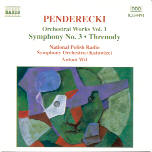Those who only know Krzysztof Penderecki from his avant-garde works of the 1960s will be surprised by his Symphony No. 3, composed in 1988-95. One could say that, in comparison to his earlier phase, this symphony is “radically traditional”, reflecting the composer’s desire to “create a synthetic and universal language” that encompasses all of the 20th century’s musical progress. It begins with a dotted rhythm pulse on the low strings and a slow, chromatic grind that climbs the orchestra’s registers, reaching a moderate climax, then begins a descent into the quiet depths again as melodic fragments flow one after another, creating an anticipatory mood. A crescendo timpani roll launches the agitated second movement–the kind of dissonant conflict-ridden music one would expect in a symphony by Honegger. The brilliant writing (featuring a killer trumpet solo) is somewhat let down by a passage of repeated notes and percussion strokes that outstays its welcome.
The Adagio, the emotional core of the piece, creates an ethereal world not unlike the first movement of Shostakovich’s Sixth Symphony with its simultaneous exploration of motion and stillness. The Passacaglia fourth movement returns to the throbbing low strings of the opening. Another arc-like structure leads to a quiet ending, leaving the impression that the symphony has (satisfactorily) concluded. But no–Penderecki, Haydn-like, saves the scherzo for the end! The moto-perpetuo is almost classical in its energy and construction; only the trio seems to lose itself in the same fragmentary “tapping” that dilutes the 2nd movement. Overall, this is a compelling work, even if it seems conservative next to the innovations of Schnittke, and perhaps dry compared to the melodic richness of Rautavaara.
The remaining works explore Penderecki’s earlier period. Threnody for the Victims of Hiroshima creates harrowing effects with its 52 strings. Flourescences for Orchestra starts out sounding like a machine shop (the score includes a typewriter!) and ends up with music that John Williams obviously borrowed for Close Encounters of the Third Kind. De natura sonoris II is less explosive than the other two pieces, yet still brilliantly original. Antoni Wit, a student of the composer, leads the National Polish Radio Symphony with excitement, virtuosity, and authority. The recorded sound is excellent.
































